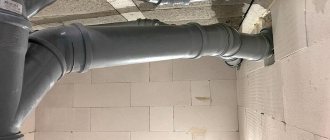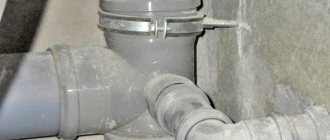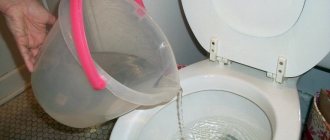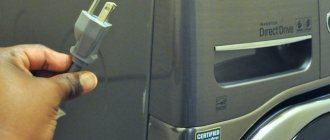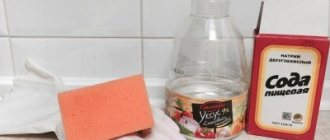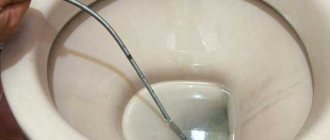Among the many options, hydrochloric acid for sewer cleaning stands out for its radical and harsh mode of action. Typically, this method is used in extreme cases when other means have not helped. Supporters and opponents of this method have endless debates about the advisability of such experiments.
The main arguments of the parties contradict each other, and reality does not confirm either one or the other argument. However, the correct application of this method can solve emerging problems. Let's take a closer look at the technology of such sewer cleaning.
Is it possible to clean pipes with hydrochloric acid without harming the pipeline?
Sometimes people are faced with the impossibility of cleaning sewer pipes using household chemicals. Store-bought products don’t work, and I don’t want to touch the cable at all. In such situations, some property owners take drastic measures - they buy strong acids and try to remove blockages with their help. The only good thing is that most radically minded people first clarify the effectiveness of using a particular solution. Thanks to this, some possible problems can be prevented.
At the same time, people are especially often interested in how to clean a sewer pipe with hydrochloric acid. On the Internet there are sometimes references to the increased efficiency of this method, so many residents want to try it in practice. But in most cases the benefit of the mentioned solution is very doubtful. Today we will tell you whether it is possible to clean pipes with hydrochloric acid and why this decision should be abandoned. At the same time, we will consider the possible consequences of using acid to clean sewers.
Is it possible to clean pipes with hydrochloric acid safely and with high efficiency?
The use of such acid is dangerous. If the substance is used incorrectly, unpleasant consequences can occur – both for pipes and for people. Next, we present several facts confirming the unsafety and low efficiency of the method in question:
- The acid has an aggressive composition that corrodes cast iron pipes . Even if plastic pipes are installed in a particular apartment, neighbors below may suffer (if they have cast iron pipes). And the plastic installed in the basement of the house is clearly not plastic.
- Acid fumes have an extremely negative effect on the skin and can also affect the respiratory and visual organs. Therefore, before cleaning a sewer pipe with hydrochloric acid, you need to buy special protective equipment and organize high-quality ventilation in the room.
- There is no control whatsoever . A person cannot determine by eye the ideal concentration of acid being poured. Therefore, it is usually either not enough to produce the required effect, or too much, which is dangerous for the pipeline. Is it possible to clean pipes with hydrochloric acid under such conditions? The question is rhetorical.
- Complete processing of the inner walls of pipes is impossible . In vertical sections, acid can theoretically coat the pipe walls, but in horizontal sections it will flow down the bottom, thereby leaving a large volume of the pipeline untreated.
The listed points are enough to ensure that the use of hydrochloric acid for cleaning pipes is unsafe and ineffective. It is simply not advisable to take risks and use this method. It is much wiser to order sewer pipe cleaning in Khabarovsk from experienced plumbers and receive the required service on favorable, and most importantly, safe terms.
So how do you clean a sewer pipe with hydrochloric acid?
Our warnings don’t scare you, and by some miracle you stocked up on hydrochloric acid? Great! Here it is, the instructions! But we warn you: we do not bear any responsibility (including financial) for your actions and for any injuries or injuries you receive. You perform all manipulations at your own peril and risk, fully aware of the dangers of this event.
- Wear personal protective equipment (at least a mask and gloves) . Additionally, organize enhanced ventilation of the room.
- Calculate the optimal acid concentration and pour the substance into the drain . It is necessary to pour in a thin stream, without splashing. The volume of acid must be sufficient to cover the maximum area of the pipe (the volume of clogs removed depends on this).
- And now, without waiting for the cleaning results, prepare... money for the possible replacement of pipes in the room, as well as for repairs to the sewer systems of neighbors and the building as a whole. At the same time, call an ambulance (just in case).
If you were seriously looking for instructions on how to clean a sewer pipe with hydrochloric acid, then we hope that the above facts have convinced you to abandon this idea. If not, then prepare for the worst consequences. With a high degree of probability they will. And it is still unknown on what scale. We hope that we have explained well whether it is possible to clean pipes with hydrochloric acid, and warned you against rash actions. Don't experiment. Don't risk your property and health. If it is difficult to remove the blockage, order mechanical or hydrodynamic cleaning. These are more effective and safer ways to achieve your goal.
Source
How to clean a drain with hydrochloric acid
Clogged drains are a common occurrence and are encountered regularly. You can eliminate it yourself, without resorting to the services of specialists. There are many ways to clean drains. One of them is the use of hydrochloric acid. The product is aggressive, but effective. Let's consider all the nuances of application and draw a conclusion about the advisability of using this chemical compound.
ATTENTION! A unique, highly effective product has been developed for cleaning sewer pipes, eliminating any blockages. The product is a concentrated mixture of enzymes that easily break down and process fat accumulations and any deposits of organic origin. One package of Saniclean will last you a whole year! Read more"
Why do clogs appear in the sewer?
The following reasons are identified:
- Washing dishes every day produces wastewater containing grease. Under the influence of detergents, it does not dissolve, but rather sticks to the walls of the pipes, forming a dense layer over time;
- Earth, sand, silt that gets into the drain as a result of daily shoe washing;
- Often the toilet is used not only for its intended purpose, but also as a place for disposing of household waste, which can be potato peelings, the remains of small construction waste;
- Various layers formed due to poor quality water composition;
- Detergents that increase the wetting efficiency of water.
Additionally, blockages can occur due to violations of equipment installation technology and its quality:
- The inner circumference of cast iron pipes, under the influence of gases released as a result of waste decomposition and constant dampness, begins to delaminate, and corrosion forms. The detachments gradually become overgrown with fat, reducing the patency of the pipes;
- The plastic sewer structure becomes clogged as a result of poor-quality installation, which has distortions and incorrect angles of inclination.
In spring, the permeability of sewer pipes decreases due to the rise of groundwater. The speed of movement of wastewater decreases, so sediments concentrate in the pipes and on their inner surface.
Depending on the type of contamination, there are 2 types of blockages:
- Deaf, formed as a result of the formation of a plug from solid waste, water from the sink does not go into the drain hole at all;
- Partial, water drains, but slowly. The blockage is formed by fatty deposits, narrows the lumen in the pipes, but does not completely block them, so the water drains, but slowly.
Regardless of the type of blockage, an unpleasant odor appears in the kitchen sink, bathtub, or washbasin.
Why do pipes get clogged and what to do about it?
Before discussing folk recipes for cleaning sewer pipes, you need to understand how the sewer system works. This will help you understand the causes of blockages, as well as find out what you can do to dissolve the resulting blockage. Of course, there are significant differences in the design of the sewer system in different buildings, but the general principle is the same everywhere.
As a rule, every house has the following elements of the sewer system:
- Main riser. This is a vertically installed large-diameter pipe through which wastewater is carried away from the apartment. It clogs extremely rarely. It should be said right away that if the riser is clogged, folk remedies are not enough.
- Sun beds. These are horizontally located pipes connecting the kitchen sink, bathtub, toilet and other plumbing fixtures to the riser. In sunbeds, blockages most often occur at the joints with the riser or siphons.
In order for waste to be drained by gravity from plumbing fixtures, the deck chairs must have a sufficient slope. If there is no slope, blockages are inevitable. Traditional recipes will help cope with a specific problem, but will not prevent the appearance of new blockages. Therefore, if the slope of the sunbeds is insufficient, major repairs will have to be carried out.
- Siphons and connecting corrugations. These are parts of complex shapes with ribbed surfaces. They create water seals - layers of water that prevent gases from the pipes from entering the home. Siphon bends are the most common place for blockages to form. Since the siphon is located closest to the drain hole, the use of folk recipes for cleaning it is most effective.
With the exception of cases where large foreign objects (rags, tufts of hair, etc.) get into the sewer system, the main cause of blockages in a properly constructed system is fat deposits in the pipes. If the system is not flushed with a sufficient amount of hot water (with modern economy, this often does not happen), grease is deposited on the walls, “cements” large particles that fall into the drain, and blocks the lumen.
The most effective method in dealing with blockages is the chemical method. It involves dissolving fatty deposits with chemically active substances. After the deposits cementing the blockage disappear, the water pressure will push large particles further through the system, and the blockage will be eliminated. This is exactly how all pipe cleaners work: from store-bought “Mole” to folk recipes.
How to clear a blockage
Before starting work, it is necessary to establish the localization of the formation of the plug. Mechanical blockages form in pipes that are not connected to the siphon, but in those areas that are cut into the system after the toilet drains.
Work with operational blockages should begin with disassembling the siphon.
If there is little water flow in the bathroom, the sink is clogged, or there is an unpleasant smell in the kitchen that cannot be removed with a freshener, you need to act immediately. With Saniclean you can easily handle the situation without a plumber. Read more"
There are several ways to clean sewer pipes:
- Mechanical, allowing you to remove debris from the drain. A brush, plunger, steel wire, or a special cable equipped with a ball or spiral are used. In the first case, the garbage is pushed through, and in the second, it is pulled out;
- Chemical. They use preparations that contain alkalis and acids. They quickly and efficiently deal with blockages.
- Thermal. Hot water is poured into the drain, which dissolves fats.
- Available means in the form of salt, baking soda or caustic soda, vinegar. The ingredients are poured into the hole, poured with vinegar and left for some time. This method will get rid of the blockage if they are located close to the drain.
How can you clean pipes?
There are a number of options for a positive solution to the sewer problem:
- thermal. This method involves the use of a powerful stream of hot water. It is quite effective in the presence of small deposits on the pipe walls;
- mechanical. To implement it, you need to use special equipment: a plunger, a plumbing cable, a hydrodynamic machine;
- chemical. It is probably used more often than others, since chemicals quickly and effectively deal with blockages.
Instructions
There are opponents and supporters of using such an aggressive method of removing blockages. The concerns are understandable, especially for residents of apartment buildings, where, if not in the house, then in the basements, there are still cast-iron sewer sections that are destroyed by hydrochloric acid. Instead of cleaning, it results in a leak. But such an outcome depends on concentration.
The reagent is contained in every chemical used in everyday life to clean sewers, which everyone uses without taking precautions. It is logical to use hydrochloric acid as an independent cleaning agent, observing the proportions.
Due to its chemical composition, it can dissolve many materials, and the acid also generates heat, which breaks down fatty deposits.
If you use acid strictly according to the rules, while observing precautions, then many fears will disappear.
Important advice! To improve sewer cleaning, you should not mix hydrochloric acid with other products, especially if they contain alkali. A reaction will occur that will negatively affect the quality of the pipes.
When working with acid, you should use protective equipment: rubber gloves, goggles, a rubber apron, and ideally a gas mask. Before starting work, it is recommended to open the windows and increase air flow.
- Close drain holes in plumbing installations;
- Dilute the acid concentration with water, bring it to a maximum level of 10%. In case of severe blockages, the percentage can be increased. In addition, it should be borne in mind that there is always water in the drain holes, upon contact with which the concentration immediately drops;
- Pour into the drain hole in a thin stream, avoiding splashing on the sides;
- The amount of solution should correspond to the size of the problem. If there is a deep blockage, the acid should penetrate the pipe as far as possible;
- Cover the drain hole with any object that will block the spread of acid vapors, maintain the time within two hours, at least 30 minutes;
- Rinse with water and test the result. If necessary, the procedure can be repeated in the same sequence.
Hydrochloric acid can get rid of any blockages that could not be removed by other means. It is easy to apply to any drain; there is no need to use mechanical means. Be sure to take precautions as with other chemical methods used to clean drains.
Try the latest Saniclean solution, which will easily remove any blockage in your pipes. The strong formula dissolves excess fat and food debris in a matter of minutes, allowing water to drain away and unpleasant odors to disappear. More details at the link.
- REMOVES ANY CLOGGES!
SaniClean not only removes blockages, but also, with regular use, prevents their occurrence. - REMOVES ODOR.
Eliminates unpleasant odors from the drain hole by killing the pathogenic bacteria contained there. - SAFE COMPOSITION.
Does not damage pipes, regardless of what material they are made of.
Find out details
Source
Prevention
To prevent the drain from becoming completely clogged, it is necessary to carry out preventive work in a timely manner (they mainly relate to prevention in the kitchen).
The easiest way to prevent blockages is to pour boiling water into the pipes every day.
And also follow the recommendations of plumbers:
- do not pour fatty liquids into the kitchen sink;
- Throw any leftover food from the dishes into the trash bin before washing;
- to protect against small food debris or hair getting into the drain, it is necessary to install a special protective mesh;
- do not throw hair from the comb into the washbasin or toilet;
- Every day you should fill the drain hole with boiling water.
You can clear clogged pipes yourself. The main thing is to choose the right methods. These are both mechanical cleaning options and chemical ones to combat old traffic jams. Folk tricks will help with minor traffic jams. But there is nothing better than timely prevention. And then you won’t have to become an amateur plumber too often.
Hydrochloric acid: household use for cleaning pipes. Hydrochloric acid and its properties
A clogged drain can create a lot of problems. Not only can the wastewater no longer pass normally through the pipes, but there is a risk of some of the wastewater returning back into the room, especially if there is a blockage in the riser, and the sewer system is actively used by neighbors above. Calling a plumber means waiting time and often a large bill for clearing even a minor blockage, so it’s easier to determine for yourself how to clean the drain at home and prepare in advance for possible problems.
Traditional methods
You can also clean pipes using means that have been tested more than once.
Soda and vinegar
Instructions:
- Pour baking soda into the drain and add vinegar in a 1:1 ratio (for the first time, you can take ½ tbsp).
- We close the hole with a plug.
- After 5–7 minutes, rinse the drain with a small pressure of hot water.
Baking soda and vinegar are the most famous folk remedy for cleaning drains.
Causes of blockages
The sewer system moves wastewater with a high content of organic matter and fats. They stick to the walls in a thin layer, which gradually grows and turns into a full-fledged blockage. As a rule, it is located near the drain hole of kitchen sinks or other plumbing fixtures. Most often, the siphon suffers from fat deposits, the bend of which actively collects sticky and viscous components of wastewater.
In addition, a common cause is foreign objects falling into the sewer. There may be hair, paper, construction waste (sand, residues of adhesive solutions), feminine pads and other unwanted components. They get stuck in bends or narrowing areas of the pipes, causing permanent blockages. No methods other than mechanical cleaning give results.
On cast iron pipes, there are cases of scale detachment from the inner surface of the walls. It remains inside and quickly becomes overgrown with fat, trapping small particles of organic matter. Mechanical cleaning of pipes will also be a solution to the problem.
How to prevent problems in the future
To understand where the blockage is, you need to put some water in the sink or bathtub and see how it drains:
- The water recedes very poorly, and it takes a lot of time. Most likely, the blockage is located further than 100 centimeters from the drain;
- The water “goes away” a little and remains in that position. The pipe clogged in the section from the siphon to the first bend;
- The water doesn't go away at all. Most often, a dirty siphon is to blame.
Now let’s look at what can cause a pipe to become clogged:
- Dirt and grease adhering to the inside of the pipe. When particles of debris begin to cling to them, this leads to a serious blockage;
- Dishwashing detergents that contain surfactants. These components create the same problem as grease and dirt;
- Limescale. It appears due to impurities in the water;
- Earth and sand. A common problem that appears in the bathroom if outdoor shoes are washed there;
- Foreign objects accidentally falling into the drain;
- Pipes made of cast iron become clogged due to the formation of rust tubercles inside them. Most often, such plaque appears in the pipe from the kitchen sink to the bathtub;
- Plastic pipes can become clogged due to improper installation. For example, if the angle of inclination is incorrect, the likelihood of a blockage increases several times.
You can clear a clogged pipe yourself. There are many different ways to do this.
Pour 200 grams into the drain. baking soda and add 200 ml to it. vinegar. After this, close the hole tightly and wait 10-15 minutes. This time is enough for the components to react and dissolve the fat formed on the walls of the pipe.
Caustic soda
To prepare the cleanser you will need 2-3 kg. caustic soda (you can buy it at a hardware store), a plastic scoop and a metal bucket.
We suggest you read: Descale an electric kettle with citric acid
Pour the powder into a bucket and add 10 liters of cold water. Stir the baking soda for at least half an hour until the powder is completely dissolved. Be careful not to get the solution on your skin. Then heat the solution on the stove to a temperature of 70 degrees. Do not let the soda boil, otherwise it will lose its properties.
Pour half the solution into the pipe and leave it for 2 hours. After the specified time, pour in the rest of the soda and wait another two hours. After this, rinse the pipes thoroughly with hot water.
Pour 100 g into the pipe. soda, and after half an hour pour 150 ml there. vinegar and chlorine. Close the hole tightly. After half an hour, you can wash off the remaining substances with hot water.
Pour 300 g into the pipe. salt, add 2 liters of boiling water and 100 ml. 70% vinegar. After half an hour, check the result. If the blockage does not go away, repeat the procedure.
Lemon acid
Pour 100 g into the pipe. citric acid, and fill it with 250 ml. hot water. After 20 minutes, rinse the pipe with plenty of hot water.
This recipe replaces the use of baking soda and greatly simplifies the process. Place a batch of tablets in the drain and then fill them with 250 ml. vinegar and 50 ml. water. Leave the product on for just a couple of minutes and rinse the pipe with hot water.
Most often, the cause of blockage is grease, which settles on the walls of the pipe if you wash dishes with cold water or a low-quality product. To avoid unpleasant consequences, try to remove food debris from dirty dishes before washing them. Once a week, run the pipe with hot water for 30-40 minutes.
Water in pipes can stagnate for several reasons:
- Cast iron pipes most often become clogged due to the appearance of corrosive irregularities on the internal walls. The section between the kitchen sink outlet and the bathroom outlet is especially susceptible to such deposits.
- Plastic pipes very often become clogged due to improper installation of sewerage equipment. The slightest violation of the angle of inclination in relation to the riser - and a jam is guaranteed.
The kitchen sink gets clogged especially often.
There are also so-called universal reasons that do not depend on the pipe material:
- Grease and dirt, sticking to the inner walls, cause small debris to cling to this coating. Gradually a dense mass is formed that does not allow water to pass through.
- Limescale deposits that settle on the walls of pipes due to impurities in the water.
- Sand and soil that gets into the sink or bathtub when washing shoes or pets.
- Foreign objects entering the sewer. You will have to call specialists who will use hydraulic installations to help cope with this problem (especially if we are talking about a high-rise apartment building), or remove the item yourself.
- Detergents with surfactants (surfactants) that enhance the ability of water to wet physical bodies. That is, the substances that make up soaps, cleaning powders and gels, etc. Surfactants act on the sewer in the same way as fat.
Thus, regardless of the material from which the sewer system is made, sooner or later everyone will have to deal with obstruction of water in the pipes. This means that you need to arm yourself with the simplest (but at the same time effective!) ways to solve the problem.
plunger
Stagnant water is not always a consequence of a clogged drain hole. Sometimes the reason lies:
- in a clogged siphon (often construction debris ends up there after repair work);
- in the incorrect bending of the corrugation that goes from the siphon to the sewer (if the siphon is a bottle type, then there must be a side outlet and an elongated lower part for the accumulation of water; if the siphon is a pipe siphon, then one of the pipes of the system must have a curved shape);
- plugs at the joints of silicone pipes, which were used to process these same joints.
You can solve the problem by eliminating the root cause:
- clean the siphon;
- check that the bend of the corrugation matches the type of siphon;
- remove the silicone plug (carefully clean it with sandpaper or the blunt side of a knife).
The sewer system moves wastewater with a high content of organic matter and fats. They stick to the walls in a thin layer, which gradually grows and turns into a full-fledged blockage. As a rule, it is located near the drain hole of kitchen sinks or other plumbing fixtures. Most often, the siphon suffers from fat deposits, the bend of which actively collects sticky and viscous components of wastewater.
In addition, a common cause is foreign objects falling into the sewer. There may be hair, paper, construction waste (sand, residues of adhesive solutions), feminine pads and other unwanted components. They get stuck in bends or narrowing areas of the pipes, causing permanent blockages. No methods other than mechanical cleaning give results.
On cast iron pipes, there are cases of scale detachment from the inner surface of the walls. It remains inside and quickly becomes overgrown with fat, trapping small particles of organic matter. Mechanical cleaning of pipes will also be a solution to the problem.
How to flush sewer pipes
The design of sewer systems is the simplest: a gravity-flow, free-flow water supply system of large diameter. Communications do not require any special maintenance, but it is this unpretentiousness that becomes the indirect cause of accidents and breakdowns. Unfortunately, there is a common belief that since the system is designed to flush, it can flush literally anything.
Cleaning sewer pipes
The condition of sewer pipes is paid attention only when they fail. The reason is dense mechanical formations - blockages that occur in places where the pipeline bends.
- The outlet of the sink and the bathroom, especially their junction - a lot of small waste gets into the kitchen sink, which is drained along with the water. But along with them, fat is washed away there, which forms a dense solid formation with mechanical particles.
- The toilet leaking is the same reason, since they pour something into the toilet that they don’t want to clog the sink with. The most dangerous of this garbage are hair, animal hair, and fabric fibers. Hair is also chemically inert and does not dissolve with ordinary household chemicals, which makes washing much more difficult.
- Communication sections are under insufficient slope - the reason here is incorrect calculations during construction.
Over time, a layer of sediment appears on the inner surface of the sewer pipe, its working cross-section decreases and the sewage system functions worse and worse. Don't wait for a lump of debris to completely block the pipe. If you notice that the water is not draining quickly enough, you should immediately begin flushing.
There are many ways. Their application depends on the nature of the accident and its scale. Start with the most affordable ones.
The simplest and most “dishonest” way. The effect is based on the fact that the resulting blockage is held in place by congealed fat.
It falls into the sink while still in a liquid state, but cools down in the sewer pipe, settling on its walls and trapping mechanical particles.
How to understand that there is a blockage in the pipes
As soon as you notice that after using the sink or bathtub, the water runs out for a long time, you can say that the pipe has become clogged. If the water does not drain at all, it means that the blockage situation has reached a critical point, or some large foreign object has entered the pipe.
In addition, an unpleasant odor, which indicates that dirt and grease residues have accumulated on the inside of the pipe, can be a clear sign of a future blockage.
Most often, the drain in the kitchen or bathroom becomes clogged. It is there that there is a lot of fat and small debris (food debris, hair) for objective reasons. The sooner you start a “war” for the free passage of water, the better. To get started, follow these simple four-step instructions:
- Boiling water. If the pipes are steel or cast iron, then you need to pour about 1 liter of boiling water into them. If they are plastic, then just run hot water from the tap in a small stream for about 20 minutes. This is an ideal way to dissolve a bar of soap that has fallen into the drain.
- Soda and salt. Add ½ tbsp to a glass of water. salt and 1 tbsp. soda, mix well and pour into the drain. After 10–15 minutes, clean it with a plunger or a rag folded into a tight ball.
- Vacuum cleaner. Quite an unusual step, but very effective. The only condition: the vacuum cleaner must have a blowing function. You need to seal the vacuum cleaner pipe with a rag and insert it into the drain. When turned on, a strong air flow will push through the resulting plug.
- Clean the siphon. To do this, remove it and, having thoroughly cleaned the inside of debris, rinse it with running water.
If the steps taken do not help, then the cork is already too dense and needs to be dealt with differently.
Before you start deep cleaning, you need to make sure that the problem is not in the sink, toilet or bathtub, but rather in the pipe. To do this, we flush water throughout the entire system and evaluate:
- water accumulates in several plumbing fixtures (for example, in a bathtub and sink), which means there is a general blockage localized at one of the points where the plumbing fixtures are connected to the sewer;
- water accumulates only in the sink (or in the bathtub, toilet, sink) - then the blockage is local, which is easiest to deal with, since it forms in the siphons, toilet water seal and filters of household appliances (washing machines, dishwashers);
- the liquid stagnates throughout the sewer system - a global blockage that requires professional intervention.
You can independently solve the problem with local and general. To do this, we disconnect the siphon, the corrugation of the sink, sink, bathtub and clean the drain holes of the sewer pipe. That is, we can pour a chemical into these holes, fill them with granules, but the main method is to clean them with a cable. And if there are no men’s hands to free the drains and work with them, then we try to influence the problem using chemical and simple methods.
If there is a blockage in the pipes, then it is necessary to clean the drains of the sewer pipes, indicated in the diagram as bends
The goal of this type of impact is to break the cork into small pieces, which can then be removed from the surface or they themselves can be easily washed down the drain. Mechanical cleaning methods are especially effective for the kitchen, where the cause of traffic jams is most often food debris.
We suggest you familiarize yourself with Soda for cleaning the washing machine from scale, dirt and unpleasant odors, reviews
plunger
This is a kind of first aid for an amateur plumber, that is, for each of us. The plunger is easy to use, and the hydraulic column that is formed due to the vacuum effect.
A plunger is a necessary device for cleaning drains that should be in every home.
Instructions:
- We fill the sink with water.
- We press the plunger to the drain and apply pressure.
- We make several forward movements, and the last, most powerful one, is to tear the plunger away from the drain hole. It is important to calculate the force correctly, otherwise you can damage the sink parts.
- If necessary, repeat 3-4 times.
To remove a blockage in the drains of bathroom or toilet pipes, you can use all of the above folk methods (with the same restrictions). But you won’t be able to use the cable in the toilet. The wire will simply run down the riser.
The easiest way to use a toilet is to use a plunger, however, it is important to choose the appropriate bowl diameter
If we are talking about a shower or bathtub, then first it is recommended to try flushing the drain with a shower hose.
Instructions:
- Remove the watering can and rubber seal from the shower hose.
- We apply a watering can to one of the drain holes and let in a strong pressure of water (preferably hot).
- Rinse for 5–10 minutes. If water flows out of other drain holes, they need to be covered with a rag.
- We repeat the procedure with all drain holes.
If the blockage is local, then most often it is located in the siphon.
Do not forget to place the container before unscrewing the siphon
Instructions:
- We unscrew the plastic nut that clamps the tube in the drain siphon.
- We pull out the siphon and lower it into a basin for further cleaning (we remove all dirt with our hands or a brush).
- Pour the soda-vinegar mixture into the pipe connected to the sewer (as described above).
- After the reaction is complete, pour a glass of vinegar into it.
- Repeat adding vinegar until the hissing stops.
- After 15–20 minutes, pour 2–3 liters of hot water (not boiling water!) into the pipe.
- We fix the siphon in place and tighten the plastic nut.
Steps 3–6 are necessary if there is a blockage in the pipe. If cleaning the siphon is a regular event not caused by water obstruction, then there is no need to use a soda-vinegar mixture.
It is logical that to eliminate the smell, you need to remove the cork - the cause of the spread of bacteria that provokes a disgusting odor.
In this case, simple tricks will help:
- Pour dry mustard into the drain, add hot water, leave for 10 minutes and rinse.
- A liquid bleach solution will also effectively eliminate the smell, although it will overpower it - not pleasant for everyone.
- Air fresheners are a quick way to eliminate the unpleasant smell from the drain, however, the problem will only be solved for literally a few hours.
A blockage is usually accompanied by an unpleasant odor from the drain.
Sometimes the cause of an unpleasant odor from the drain may be the lack of a water seal - a kind of water lock that prevents the smell from escaping from the sewer into the apartment. A siphon provides a water seal in the sewer system. Incorrect installation of the latter can cause odors to enter the rooms.
The solution to the problem depends on the type of siphon:
- If the siphon is a bottle type, then it is necessary to adjust the location of the drain pipe so that it is two to three centimeters below the water level. Otherwise, the evaporation will pass over the water lock.
- If the siphon is a pipe siphon, then perhaps the drain pipe has straightened out for some reason or was initially installed incorrectly. In this case, it just needs to be given the desired shape to ensure the formation of a normal water seal and fixed in this position with special clips.
- Operational.
You won't be able to avoid them. Grease from dishes, softened by detergents and hot water, flows down the drain, where it settles. Fatty sediment settles on the walls, food debris sticks to it, and a traffic jam occurs. 2-3 months after the start of the process, the lumen of the sewer pipe will be almost completely clogged. - Plugs of mechanical origin. They most often occur in common sewers, as well as in pipes leading from the toilet. Napkins, toilet paper, hair stick perfectly to the walls of pipes, especially cast iron ones. Dealing with such a blockage is not always easy.
- Technical. In new houses, such blockages arise as a result of engineering miscalculations - incorrect pipe diameter, angle of rotation, general slope. All types of pipes are susceptible, but most of all - corrugated ones.
Note! Blockages occur more often if the pipes are cast iron - their inner surface is rough and chipped, which means it is easier for fat to “catch” on it. With modern plastic pipes this problem is less common - their walls are smooth.
Before cleaning the sewer, you need to understand where the communications are clogged. The choice of method to solve the problem depends on this, as well as on the type of plug.
Traffic jams and blockages rarely occur on direct sections of communications. Most often, this problem occurs in places where the pipe turns, narrows, and also in the area where it joins the central riser. The last problem is typical for apartment buildings; it practically does not occur in one-story buildings.
- the water first “leaves”, then its level does not decrease - the area is clogged at a distance of more than 1.5 m from the point;
- the level drops slightly, then there are no changes - most likely the area from the siphon to the first turn is clogged;
- the water does not go anywhere - with a 90% probability there is a blockage in the siphon.
If you have modern networks, then the siphon and the adjacent pipes are made of plastic. Shine the entire route with a regular flashlight - where the traffic jam occurs, you will find a darker spot than in other areas.
Remedies
The most effective methods include mechanical cleaning. It is simple and easy to do yourself. A plumbing cable is used, which is inserted into the pipe and pushed inside with rotational movements.
When contact with the blockage occurs, the cable tip destroys the plug. After this, the internal cavity of the pipelines is washed with a strong stream of water.
There is hydrodynamic cleaning. It is produced using special equipment. The essence of the method is to immerse a thin hose with a special tip, from which a stream of water shoots out under strong pressure. The effectiveness of this method is higher than that of alternative types of cleaning.
The use of chemicals, as a rule, is carried out only to clean the internal areas of the system. There are many formulations on sale that contain alkaline or acidic components. Sometimes drain cleaning with hydrochloric acid is used. This is an extremely dubious and dangerous method that can do more harm than good.
Using regular salt and soda
If there are no means at hand, salt is often used to clean the drain. It is poured generously into the drain hole and left for some time. Salt eats away fat deposits and makes them loose. After some time, the siphon is washed with a strong stream of water, removing organic particles.
To enhance the effect, make a mixture of soda and salt. The proportions vary, but the effect is usually the same. Please note that regular baking soda is not suitable. You need a caustic that can effectively interact with fats. In addition, caustic soda can dissolve more complex blockages. For example, hair that does not interact well with most chemicals.
However, this method is only suitable for blockages located near the drain. If the problem section of the pipe is further away, more radical remedies are needed.
Which cleaning method to choose in which case?
For fresh clogs formed by mucus and dirt, you should choose all the recipes using baking soda and Mole. If the clog is caused by stuck hair, use Floop.
For old traffic jams, Mister Muscle, Pothan, Alco-Seltzer and caustic soda are suitable. In addition, such a blockage can be eliminated with a plunger, which will simply break it.
Citric acid removes limescale plugs. For cast iron pipes, a recipe with coarse salt is suitable. For plastic pipes you can use Mole or Pothan.
If you need to remove a foreign object, use a plumbing cable or disassemble the siphon.
Special chemicals
Mr. Muscle
The powder does a good job of removing clogs and disinfecting the surface of the pipe. Pour the contents of the bag into the pipe, and carefully pour the powder with a glass of warm water. After half an hour, rinse the drain thoroughly. One bag is enough to deal with the blockage, and it costs no more than 100 rubles.
This is a very inexpensive domestic product that can be used to remove completely different blockages. Pour in 200-250 ml. into the drain and leave the product for 2 hours. After the specified time has passed, rinse the pipe with strong water pressure. If the blockage cannot be cleared the first time, use the product again. Mole costs much less than imported analogues, no more than 70 rubles.
Pothan
Before use, lower the water level in the drain by 5 cm. Then fill in 100 ml. products and 100 ml. boiling water After 5 minutes, rinse the drain with warm water. The product is suitable for all blockages in cast iron and plastic pipes.
Pour the product into the drain and add hot water. The required proportions are indicated on the packaging. Then rinse the drain thoroughly with cold water. The product is very caustic, so put on gloves, a respirator and a protective apron or special suit before using it.
There are methods that will help get rid of a blockage in the pipe. You can implement them at home without much expense, since everyone has the proposed materials and tools. However, they are not suitable for every case and are not always effective.
This option is the simplest. All you need is boiling water and coarse salt. Can be used to clean cast iron non-separable siphons in the kitchen sink. You can add citric acid as an enhancer.
- If there is any water left, remove it and dry the sink.
- Pour 200 g of salt into the drain hole ("extra" is not suitable).
- Pour two liters of boiling water into the drain.
- Wait 30 minutes and check the result.
- If necessary, repeat the procedure.
This method is not suitable for cleaning plastic pipes (due to their sensitivity to temperatures of 1000C), as well as for bathtub and toilet drains. The reason is that salt and boiling water are effective only against fatty plugs; they cannot cope with mechanical blockages.
We suggest you read How to remove stains from clothes at home
It’s not for nothing that this method is called environmentally friendly - it is not harmful to the person who uses it and to pipes. You will need baking soda, white vinegar and boiling water. Also have a rag or sponge ready to cover the drain hole.
- Pour half a pack of dry soda down the drain.
- Pour 0.5 cups of preheated vinegar
- Cover the drain with a rag or sponge so that the reaction between vinegar and soda occurs inside the pipes.
- Leave everything for half an hour.
- Pour 1.5-2 liters of boiling water into the drain.
Using the most effective means
Today you can buy chemicals for removing plugs of any origin (except mechanical). They are different in composition, price, different active ingredients, packaging.
But the main thing is that among the large number of advertised products, you need to choose the one that will solve your sewer problems. Therefore, you need to not only believe the commercials, but also read consumer reviews. This is how you can find out which is the most effective means for cleaning sewer pipes.
"MOLE"
Everyone has probably heard about this cleaning product. Yes, we are talking about a substance for cleaning mole pipes, which is one of the most common and high-quality preparations that is in deserved demand. Although the chemical is produced by different manufacturers, the ingredients of the product remain the same. They differ in different auxiliary components.
For example, a domestic drug is a liquid, granules or gel, which consists of:
- purified water, in combination with a softening agent;
- sodium hypochloride (sodium hypochlorite);
- alkalis;
- acids;
- nonionic surfactant.
The drug is quite easy to use. Before pouring the chemical into the sink or bathtub, you must wait until the water comes out. After the product enters the system, wait a couple of hours, then rinse the entire pipeline with plenty of water.
Many consider “Mole” to be the most effective reagent in the fight against any pipe blockages. And the drug is relatively cheap.
"MISTER MUSCLE"
Mister muscle (granules or gel) for cleaning pipes is a chemical product that does not need advertising, as evidenced by numerous reviews. Mister muscle for pipes in the form of a gel is almost equally popular.
With its help, you can easily clean sewer pipes of fatty deposits, as well as other contaminants. The product not only cleans the sewer system well, but also eliminates unpleasant odors. In addition, the composition provides for the presence of antibacterial components that can easily cope with pathogenic microorganisms found in the sewer. One of the most important ingredients of the chemical is sodium hydroxide.
As the instructions indicate, Mr. Muscle gel for pipes can be used when there is no water in the sink. Therefore, before using the substance, you must first completely remove all liquid from the bathtub, from the drain hole.
After this, pour the contents of the vial or bottle completely into the hole and wait 5-7 minutes. Then, in order to wash out all the dirt and alkali for cleaning the pipes, you need to drain a lot of hot water into the system.
If the blockage is severe enough, then you should increase the duration of action of the drug or use Mr. Muscle in granules, the composition of which is the same as the gel.
Although this does not mean that you need to wait 2-3 hours or leave it overnight. In no case, since the chemical is not so much harmful to plastic as it is to the human body if used not according to the instructions. Therefore, safety rules come first.
Application of hydrochloric acid
Hydrochloric acid is a reliable fat solvent. At the same time, it is a dangerous and aggressive chemical composition. It can cause considerable harm to pipelines and people cleaning them.
Many users doubt whether it is possible to clean drains with hydrochloric acid. Their fears are quite reasonable:
- the composition is capable of corroding cast iron pipes. For residents of apartment buildings, this is a very real danger, since almost everywhere in the basement the sewage system is cast iron;
- acid vapors have a negative effect on the organs of vision, breathing, and human skin. The use of protective equipment and enhanced ventilation of the room is required;
- Cleaning the sewer with acid is done blindly. The apartment owner simply pours a large amount of acid into the drain hole and waits for the result. It cannot influence in any way the quality or efficiency of the process;
- Instead of cleaning and removing the blockage, you may end up with leaks in the cast iron parts of the system, which will require serious repairs. However, the original problem will remain.
Some sources recommend using hydrochloric acid with a concentration of no more than 3-10%. In their opinion, this will help protect cast iron pipes from contact with aggressive chemicals. However, it is clearly not possible to dissolve fat deposits from many years ago in this way.
Important
There is one more important point. Acid is poured into the plumbing drain hole. If there is water in the siphon, the concentration will drop sharply and the expected result will not be obtained. If you remove water before flushing the sewer with hydrochloric acid, the composition will only pass through the lower part of the pipelines. There will be no impact on the top of the pipe lumen. It is unrealistic to pour such an amount of chemical into the system to completely cover the section. This raises doubts about the effectiveness of the technique.
Proponents of sewer cleaning using similar methods proceed from general ideas about the properties of materials. They do not take into account the multiple factors that reduce the effectiveness of the composition. Hydrochloric acid for drain cleaning gives the desired effect only at a fairly high concentration. However, the density of the solution is difficult to maintain in the desired state. Residual water in the pipes significantly reduces the concentration of the composition. The only component of the system that receives fairly complete contact with the acid is the siphon.
However, it is easier to disassemble and perform mechanical cleaning. It will take much less time and will not require noticeable effort.
You may also like:
How to clean the drain and remove the blockage with your own hands
Cleaning sewer wells: methods and techniques
Useful tips
True professionals willingly share their experience in cleaning pipes from blockages that may arise during pipeline operation. If you listen to their recommendations, the cleaning procedure will be easy and safe, and the system itself will serve for a long time and with high quality.
- You cannot neglect any point in the instructions for chemical preparations; you must accurately use the exposure time of the reagent. Otherwise, the process of destruction of the material from which the pipeline is made may begin.
- After carrying out the cleaning procedure yourself, the remaining reagents should be washed out with plenty of hot water, which will save the system for many years.
- Carefully read all texts on the packaging of the product. It may happen that you accidentally purchased a prophylactic drug, in which case it is used only for minor contamination of the system.
- “Eliminates fatty deposits in standing liquids” - this should be approximately the inscription on the packaging of products that can remove significant fatty plugs.
Important! It is necessary to choose the exact chemical depending on the type of blockage. This means that in some cases it is necessary to use weakly active substances. And vice versa: if there are “powerful” fatty deposits, then you need to use a potent drug.
Video
How to clean drains at home: tools and equipment
A clogged drain can create a lot of problems.
Not only can the wastewater no longer pass normally through the pipes, but there is a risk of some of the wastewater returning back into the room, especially if there is a blockage in the riser, and the sewer system is actively used by neighbors above.
Calling a plumber means waiting time and often a large bill for clearing even a minor blockage, so it’s easier to determine for yourself how to clean the drain at home and prepare in advance for possible problems.
By cable
The cable consists of thin steel spring strands twisted together. You must first remove the siphon under the sink or bathtub, dismantle the toilet, or open the audit.
After this, the end of the cable with fluffed strands or a special tip is inserted into the sewer pipe. While moving the cable little by little, it should be turned using the handle at its other end.
Due to rotation, the cable actively cleans the pipe walls of plaque and at the same time helps to overcome bends and turns.
When the cable rests against a blockage, it should be pushed back five centimeters and, starting active turns and forward movements, try to break through the debris plug. By pouring a bucket of water into the sewer pipe, the effectiveness of cleaning is checked; even if the problem has already been eliminated, you need to continue working and walk through the pipe two or three times with a cable with twists.
Step-by-step instruction
Before cleaning the drain with hydrochloric acid, it is necessary to prepare personal protective equipment. In addition, it is necessary to organize enhanced ventilation of the room. Procedure:
- pour a chemical composition into the drain hole. Hydrochloric acid is fed into the sewer carefully, in a thin stream, so as not to splash around. It should be enough for the solution to travel as far as possible through the pipe;
- stand for a certain time. We recommend covering the drain hole with a lid, rag or other object. The composition should be kept for as long as possible and for at least half an hour;
- release a strong stream of water and rinse the pipe cavity well.
Sometimes sulfuric acid is used instead of hydrochloric acid to clean drains. Cleaning the system in this way is even more dangerous, since sulfuric acid vapors are highly concentrated. In addition, it is effective only in high concentrations, which makes its use unreasonably dangerous.
Source
Rinse the pipes with boiling water
The easiest way to implement it on your own. All you need to remove the plug is hot water or boiling water.
The procedure looks like this:
- Open the tap and fill the sink (or bathtub) with hot water. Its temperature is about +70°C. This is enough to dissolve fat. But you can also prepare boiling water by boiling water in a saucepan or kettle.
- Close the tap. We wait until the water completely goes into the drain hole.
- We repeat the procedure several times. You can tell that the result has been achieved by the rate of water drainage: when the blockage is destroyed, the sink will begin to empty freely.
The method has many disadvantages:
- First of all, its effectiveness is maximum when the blockage has recently formed. But if the cork formed a long time ago, having had time to dry thoroughly, boiling water will not be able to dissolve it.
- Another drawback is the high consumption of hot water (which will affect utility bills).
- The method is recommended only for metal pipes. Plastic pipes, as well as siphons, corrugations, and boiling water gaskets may lose their tightness.
Before flushing the pipe with boiling water, pay attention to the nature of water stagnation. If it goes down the drain until a certain point, and then starts to build up, the blockage is located too far from the siphon. In this case, the washing efficiency will be extremely low.
Flushing your pipes with hot water is easy to do and does a good job of removing fresh clogs. But still, this folk method can hardly be called a means of effectively combating traffic jams in the sewer system: it is rather preventative.

